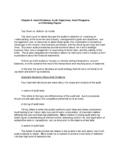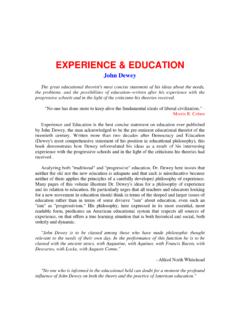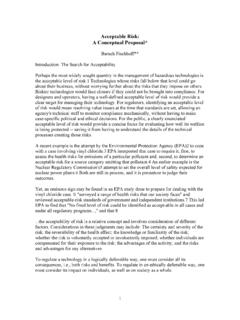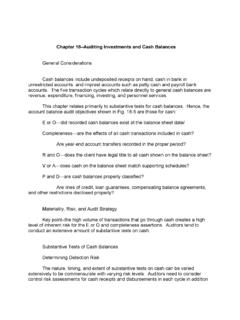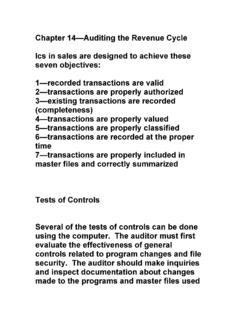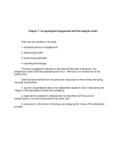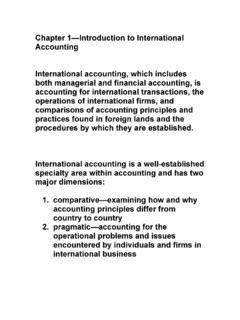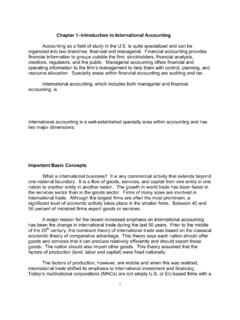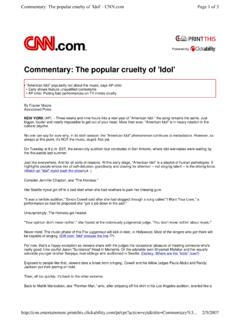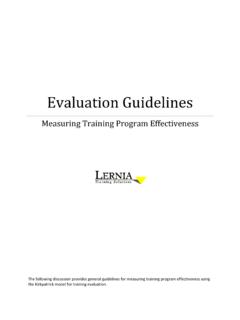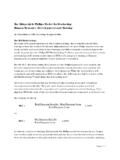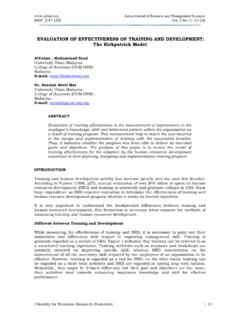Transcription of Kirkpatrick's Four-Level Training Evaluation Model - MindTools
1 Get the Free NewsletterLearn new career skills every week, and get ourPersonal Development Plan Workbook FREE when you ME UPPrivacy Policy (/ )First nameEmailBy theMind ToolsEditorial TeamKirkpatrick's Four-LevelTraining Evaluation ModelAnalyzing Training EffectivenessIf you deliver Training for your team or your organization,then you probably know how important it is to measure itseffectiveness. After all, you don't want to spend time ormoney on Training that doesn't provide a good is where Kirkpatrick's Four-Level Training Evaluation Model can help you objectivelyanalyze the effectiveness and impact of your Training , so that you can improve it in theeffectiveness of yourtraining at four levels.
2 IStockphotoPauuletHohnKirkpatrick's Four-Level Training Evaluation Model - of 72/17/17, 4:33 PMIn this article, we'll look at each of the four levels of the kirkpatrick Model , and we'llexamine how you can apply the Model to evaluate Training . We'll also look at some of thesituations where it may not be Four LevelsDonald kirkpatrick , Professor Emeritus at the University of Wisconsin and past president ofthe American Society for Training and Development (ASTD), first published his Four-LevelTraining Evaluation Model in 1959, in the US Training and Development Model was then updated in 1975, and again in 1994, when he published hisbest-known work, "Evaluating Training Programs.
3 "The four levels Let's look at each level in greater 1: ReactionThis level measures how your trainees (the people being trained), reacted to the , you want them to feel that the Training was a valuable experience, and youwant them to feel good about the instructor, the topic, the material, its presentation, andthe 's important to measure reaction, because it helps you understand how well the trainingwas received by your audience. It also helps you improve the Training for future trainees,including identifying important areas or topics that are missing from the 2: LearningAt level 2, you measure what your trainees have learned.
4 How much has their knowledgeKirkpatrick's Four-Level Training Evaluation Model - of 72/17/17, 4:33 PMincreased as a result of the Training ?When you planned the Training session, you hopefully started with a list of specific learningobjectives: these should be the starting point for your measurement. Keep in mind thatyou can measure learning in different ways depending on these objectives, anddepending on whether you're interested in changes to knowledge, skills, or 's important to measure this, because knowing what your trainees are learning and whatthey aren't will help you improve future 3: BehaviorAt this level, you evaluate how far your trainees have changed their behavior, based onthe Training they received.
5 Specifically, this looks at how trainees apply the 's important to realize that behavior can only change if conditions are favorable. Forinstance, imagine you've skipped measurement at the first two kirkpatrick levels and,when looking at your group's behavior, you determine that no behavior change has takenplace. Therefore, you assume that your trainees haven't learned anything and that thetraining was , just because behavior hasn't changed, it doesn't mean that trainees haven'tlearned anything. Perhaps their boss won't let them apply new knowledge. Or, maybethey've learned everything you taught, but they have no desire to apply the 4: ResultsAt this level, you analyze the final results of your Training .
6 This includes outcomes that youor your organization have determined to be good for business, good for the employees, orgood for the bottom with permission of Berrett-Koehler Publishers, Inc., San Francisco, CA. From Evaluating Training Programs, 1996 by Donald & James D kirkpatrick . All rights reserved. :Make sure that you plan your Training effectively. Use our articles on Training NeedsAssessment, Gagne's Nine Levels of Learning and 4 MAT to help you do 's Four-Level Training Evaluation Model - of 72/17/17, 4:33 PMHow to Apply the ModelLevel 1: ReactionStart by identifying how you'll measure reaction. Consider addressing these questions:Did the trainees feel that the Training was worth their time?
7 Did they think that it was successful?What were the biggest strengths of the Training , and the biggest weaknesses?Did they like the venue and presentation style?Did the Training session accommodate their personal learning styles?Next, identify how you want to measure these reactions. To do this you'll typically useemployee satisfaction surveys or questionnaires; however you can also watch trainees'body language during the Training , and get verbal feedback by asking trainees directlyabout their you've gathered this information, look at it carefully. Then, think about what changesyou could make, based on your trainees' feedback and 2: LearningTo measure learning, start by identifying what you want to evaluate.
8 (These things couldbe changes in knowledge, skills, or attitudes.)It's often helpful to measure these areas both before and after Training . So, before trainingcommences, test your trainees to determine their knowledge, skill levels, and Training is finished, test your trainees a second time to measure what they havelearned, or measure learning with interviews or verbal 3: BehaviorIt can be challenging to measure behavior effectively. This is a longer-term activity thatshould take place weeks or months after the initial these questions: Kirkpatrick's Four-Level Training Evaluation Model - of 72/17/17, 4:33 PMDid the trainees put any of their learning to use?
9 Are trainees able to teach their new knowledge, skills, or attitudes to other people?Are trainees aware that they've changed their behavior?One of the best ways to measure behavior is to conduct observations and interviews , keep in mind that behavior will only change if conditions are favorable. For instance,effective learning could have taken place in the Training session. But, if the overallorganizational culture isn't set up for any behavior changes, the trainees might not be ableto apply what they've , trainees might not receive support, recognition, or reward for their behaviorchange from their boss. So, over time, they disregard the skills or knowledge that theyhave learned, and go back to their old 4: ResultsOf all the levels, measuring the final results of the Training is likely to be the most costlyand time consuming.
10 The biggest challenges are identifying which outcomes, benefits, orfinal results are most closely linked to the Training , and coming up with an effective way tomeasure these outcomes over the long are some outcomes to consider, depending on the objectives of your Training :Increased employee quality customer staff 's Four-Level Training Evaluation Model - of 72/17/17, 4:33 PMConsiderationsAlthough Kirkpatrick's Four-Level Training Evaluation Model is popular and widely used,there are a number of considerations that need to be taken into account when using issue is that it can be time-consuming and expensive to use levels 3 or 4 of themodel, so it's not practical for all organizations and situations.
